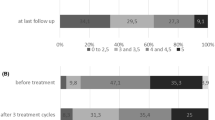Abstract
A decrease in sensory nerve action potentials (SNAP) amplitude has been recently reported in some patients during the course of multifocal motor neuropathy with conduction blocks (MMNCB). It is not known if those patients have different clinical expression and disability when compared with typical MMNCB. Clinical, biological and electrophysiological assessments were performed in 15 patients fitting the diagnosis criteria of MMNCB, including normal SNAP amplitude at initial examination. Patients presenting with nerve entrapment or associated disease causative of sensory neuropathy were excluded. Median time of follow-up was 3 years (1–17 years). At the last examination, four patients had at least one SNAP amplitude below 50% of normal value. None had clinically objective sensory loss. Clinical and electrophysiological data obtained at the last examination were compared between patients with normal SNAP amplitude and patients with decreased SNAP amplitude. No difference between both population in term of age, sex, disease duration, anti-GM1 antibody titers, CSF data and number of conduction blocks was noted. In contrast, patients with decreased SNAP amplitude had worse overall neuropathy limitation scale (ONLS) scores (7 vs. 2; p = 0.02), a higher number of affected nerves (12.5 vs. 4; p = 0.018), a higher number of affected limb regions (6 vs. 2; p = 0.019) and lower median CMAP amplitude (2 mV vs. 6.5 mV; p = 0.04). They were all dependent on higher doses of IVIg (1.4 g/(kg 4 weeks vs. 0.6; p = 0.018). A reduction in SNAP amplitude during the course of MMNCB is associated with a more severe disease and a more prominent axonal loss. This result needs to be confirmed in a larger cohort.
Similar content being viewed by others
References
Azulay JP, Blin O, Boucraut J, Pouget J, Serratrice G (1994) Intravenous immunoglobulin treatment in patients with motor neuron syndromes associated with anti-GM1 antibodies: a double blind placebo controlled trial. Neurology 44:429–432
Bouche P, Moulonguet A, Younes-Chennoufi AB et al (1995) Multifocal motor neuropathy with conduction block: a study of 24 patients. J Neurol Neurosurg Psychiatry 59(1):38–44
Corse AM, Chaudhry V, Crawford TO, Cornblath DR, Kuncl RW, Griffin JW (1996) Sensory nerve pathology in multifocal motor neuropathy. Ann Neurol 39(3):319–325
Delmont E, Azulay JP, Giorgi R, Attarian S, Verschueren A, Uzenot D, Pouget J (2006) Multifocal motor neuropathy with and without conduction block, a single entity? Neurology 67:592–596
European federation of neurological societies/peripheral nerve society guideline on management of multifocal motor neuropathy (2006) Eur J Neurol 13:802–80
Graham RC, Hughes RA (2006) A modified peripheral neuropathy scale: the overall neuropathy limitations scale. J Neurol Neurosurg Psychiatry 77:973–976
Krarup C, Stewart JD, Sumner AJ, Pestronk A, Lipton SA (1990) A syndrome of asymmetric limb weakness with motor conduction block. Neurology 40(1):118–127
Lambrecq V, Krim E, Rouanet-Larriviere M, Lagueny A (2009) Sensory loss in multifocal motor neuropathy: a clinical and electrophysiological study. Muscle Nerve 2:131–136
Leger JM (1995) Multifocal motor neuropathy and chronic inflammatory demyelinating polyradiculoneuropathy. Curr Opin Neurol 8:359–363
Lewis RA, Sumner AJ, Brown MJ, Asbury AK (1982) Multifocal demyelinating neuropathy with persistent conduction block. Neurology 32:958–964
Lievens I, Fournier E, Viala K, Maisonobe T, Bouche P, Léger JM (2009) Multifocal motor neuropathy: a retrospective study of sensory nerve conduction velocities in long-term follow-up of 21 patients. Rev Neurol 165:243–248
Medical Research Council (1976) Aids to the examination to the peripheral nervous system. Her Majesty’s Stationary Office 1–2, London
Nobile-Orazio E, Meucci N, Barbieri S, Carpo M, Scarlato G (1993) High-dose intravenous immunoglobulin therapy in multifocal motor neuropathy. Neurology 43(3 Pt 1):537–544
Olney R, Lewis R, Putnam T, Campellone J (2003) American association of electrodiagnostic medicine. Consensus criteria for the diagnosis of multifocal motor neuropathy. Muscle Nerve 27:117–121
Parry GJ, Clarke S (1988) Multifocal acquired demyelinating neuropathy masquerading as motor neuron disease. Muscle Nerve 11:103–107
Rajaballly YA, Chavada G (2009) Lewis–Sumner syndrome of pure upper-limb onset: diagnostic, prognostic, and therapeutic features. Muscle Nerve 39(2):206–220
Van Asseldonk JT, Van den Berg LH, Kalmijn S, Van den Berg-Vos RM, Polman CH, Wokke JH, Franssen H (2006) Axon loss is an important determinant of weakness in multifocal motor neuropathy. J Neurol Neurosurg Psychiatry 77(6):743–747
Verschueren A, Azulay JP, Attarian S, Boucraut J, Pellissier JF, Pouget J (2005) Lewis–Sumner syndrome and multifocal motor neuropathy. Muscle Nerve 31(1):88–94
Viala K, Renié L, Maisonobe T et al (2004) Follow-up study and response to treatment in 23 patients with Lewis–Sumner syndrome. Brain 127(Pt 9):2010–2017
Vucic S, Black K, Chong PS, Cros D (2007) Multifocal motor neuropathy with conduction block: distribution of demyelination and axonal degeneration. Clin Neurophysiol 118(1):124–130
Acknowledgment
We thank Pr Said Beydoun for revision of the manuscript.
Author information
Authors and Affiliations
Corresponding author
Rights and permissions
About this article
Cite this article
Delmont, E., Benaïm, C., Launay, M. et al. Do patients having a decrease in SNAP amplitude during the course of MMN present with a different condition?. J Neurol 256, 1876–1880 (2009). https://doi.org/10.1007/s00415-009-5217-0
Received:
Revised:
Accepted:
Published:
Issue Date:
DOI: https://doi.org/10.1007/s00415-009-5217-0




